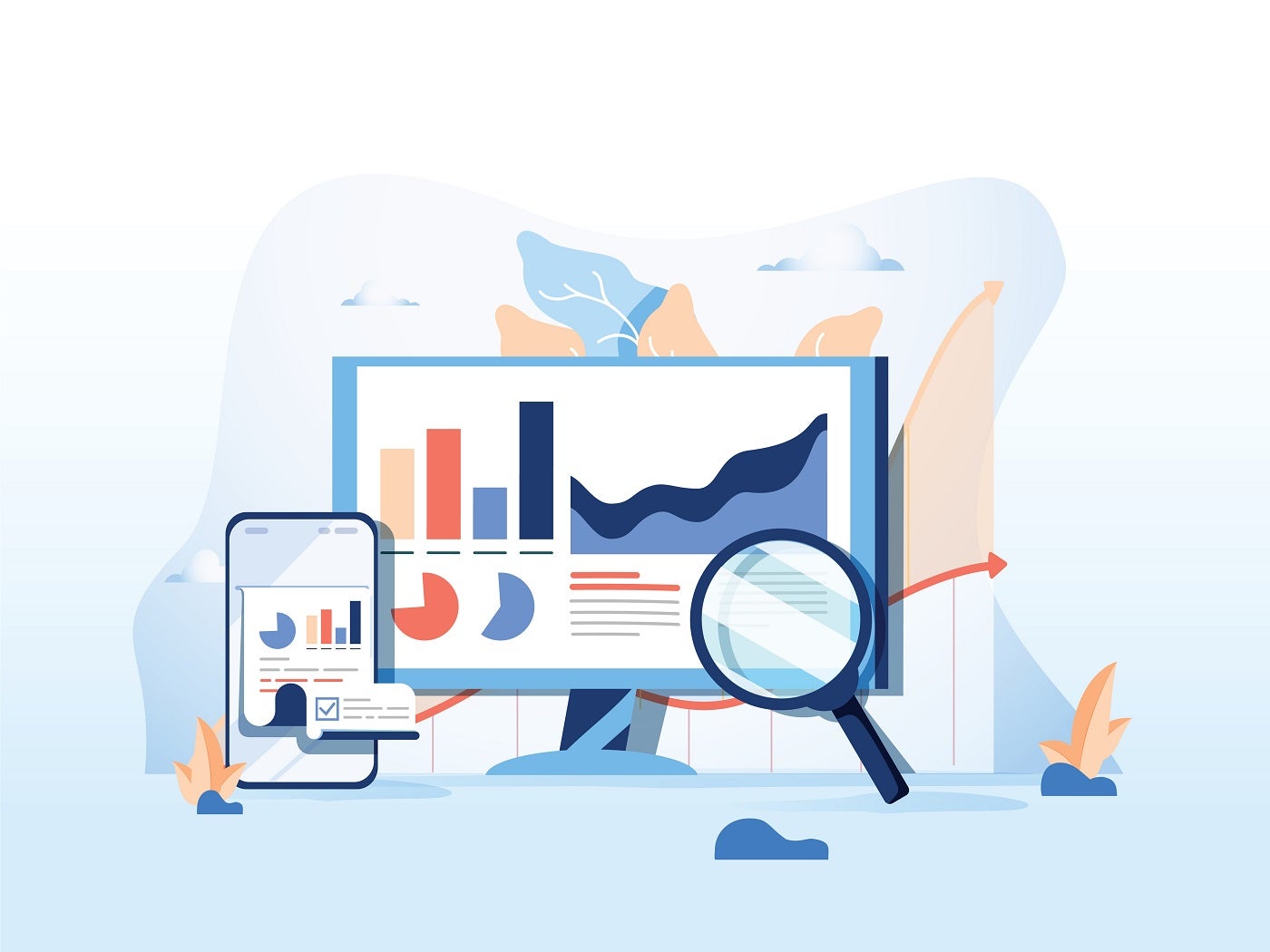- Best for comprehensive data integration: Zoho Analytics
- Best for task-based reporting: Asana
- Best for high-level project reporting: Hive
- Best for data-driven decision-making: Google Looker
- Best for customizable project reporting: Wrike
- Best for visual project tracking: monday.com
- Best for all-in-one project management: ClickUp
- Best for agile project management: Jira Software
- Best for data visualization: Tableau
- Best for Microsoft ecosystem integration: Power BI
Reporting tools and software are crucial to teams, especially in terms of project management as they provide a structured way to track progress, identify risks and make informed decisions. They offer a sweeping view of project health that helps managers to not only pinpoint areas of concern but also identify successes. With effective reporting, an organization gets transparency and ensures its stakeholders are aligned, which plays a part in making projects successful since everyone involved has access to the same information and insights. We’ve analyzed 10 top reporting tools and software worth your consideration.
Featured Partners
Top reporting software: Comparison table
| Software | Real-time analytics | Data visualization | Dashboard customization | Automated reporting | Free plan | Starting price |
|---|---|---|---|---|---|---|
| Zoho Analytics | Yes | Yes | Yes | Yes | No | $22/month |
| Asana | Limited | Limited | No | Limited | Yes | $10.99/user/month |
| Hive | Yes | Yes | Yes | Yes | Yes | $12/user/month |
| Google Looker | Yes | Yes | Yes | Yes | Yes | Contact for pricing |
| Wrike | Yes | Yes | Yes | Yes | No | $9.80/user/month |
| monday.com | Yes | Yes | Yes | Yes | Yes | $9/user/month |
| ClickUp | Yes | Yes | Yes | Yes | Yes | $7/user/month |
| Jira Software | Yes | Yes | Limited | Yes | Yes | $8.15/user/month |
| Tableau | Yes | Yes | Yes | Yes | No | $15/user/month |
| Power BI | Yes | Yes | Yes | Yes | Yes | $10/user/month |
Zoho Analytics: Best for comprehensive data integration

Zoho Analytics is a reporting tool that excels at aggregating data from a wide array of sources as it connects with over 250 data sources, including files, feeds, databases and cloud services. Its comprehensive suite of reporting options includes charts, pivot tables, summary views, tabular views and more. Zoho Analytics also offers an intuitive drag-and-drop interface to further simplify the report creation process and make it accessible for users of varying skill levels.
Pricing
Zoho Analytics offers plans starting at $22 per month for the Basic plan, while the Standard, Premium and Enterprise plans cost $45, $112 and $445 per month, respectively, when billed annually. There’s also a Custom plan for prospective users to share their requirements.
Features
- Extensive data integration from over 250 sources.
- Data preparation and management tools for accurate analysis.
- A wide array of visualization options for insightful reporting (Figure A).
- AI and ML-powered augmented analytics for guided insights.
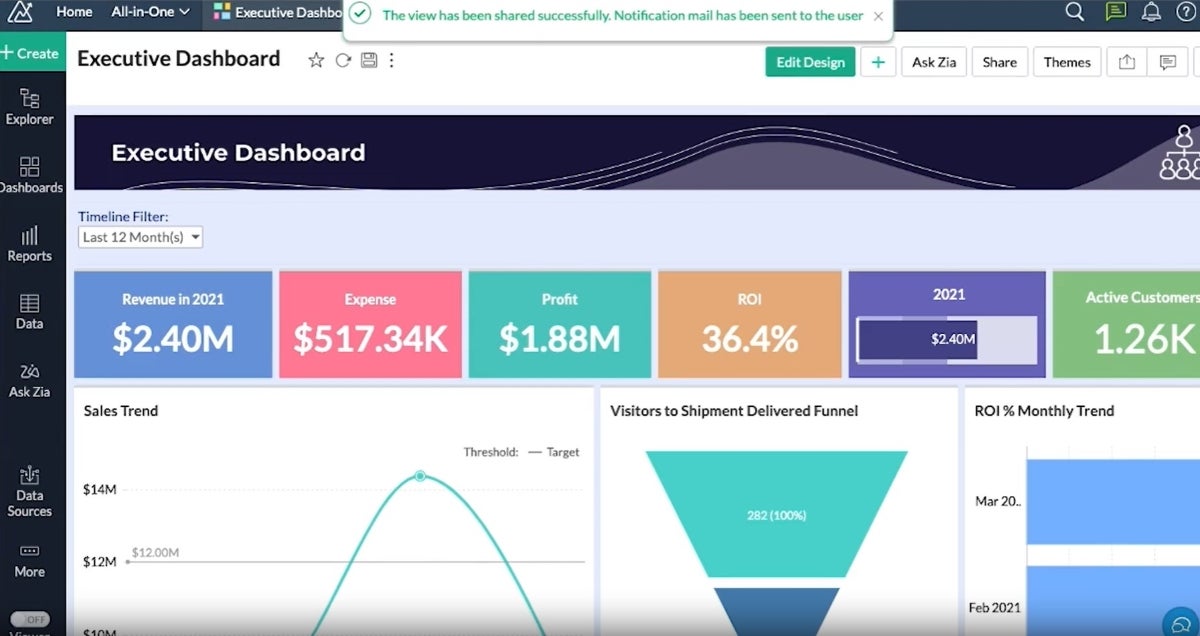
Integrations
Zoho Analytics’s integrations include Zoho CRM, Salesforce CRM, Microsoft Dynamics CRM, HubSpot CRM and Zoho Bigin.
Pros
- Comprehensive data integration capabilities.
- Wide range of visualization tools.
- Advanced augmented analytics features.
Cons
- May be complex for beginners.
- Customization can require a learning curve.
Why we chose Zoho Analytics
We selected Zoho Analytics for its broad range of reporting capabilities and user-friendly design. Its ability to present data in various visual formats makes analysis flexible and insightful and caters to diverse reporting needs as well as a wide variety of users.
Learn more about other Zoho products, like Zoho Projects and Zoho Vault.
Asana: Best for task-based reporting

Asana simplifies project management with its Universal Reporting feature, which provides teams with a clear overview of task progress and project health. Its visual reporting format is designed for easy interpretation, meaning that users at all levels within an organization can easily access and use Asana.
Pricing
Asana’s paid plans include the Premium plan at $10.99 per user per month, billed annually, and the Business plan at $24.99 per user per month. Its Enterprise plan’s pricing hasn’t been listed publicly.
Features
- Visual and intuitive reporting tools for task and project tracking (Figure B).
- Goal tracking to align daily tasks with strategic objectives.
- Real-time updates to keep teams informed on project progress.
- A variety of highly customizable charts.
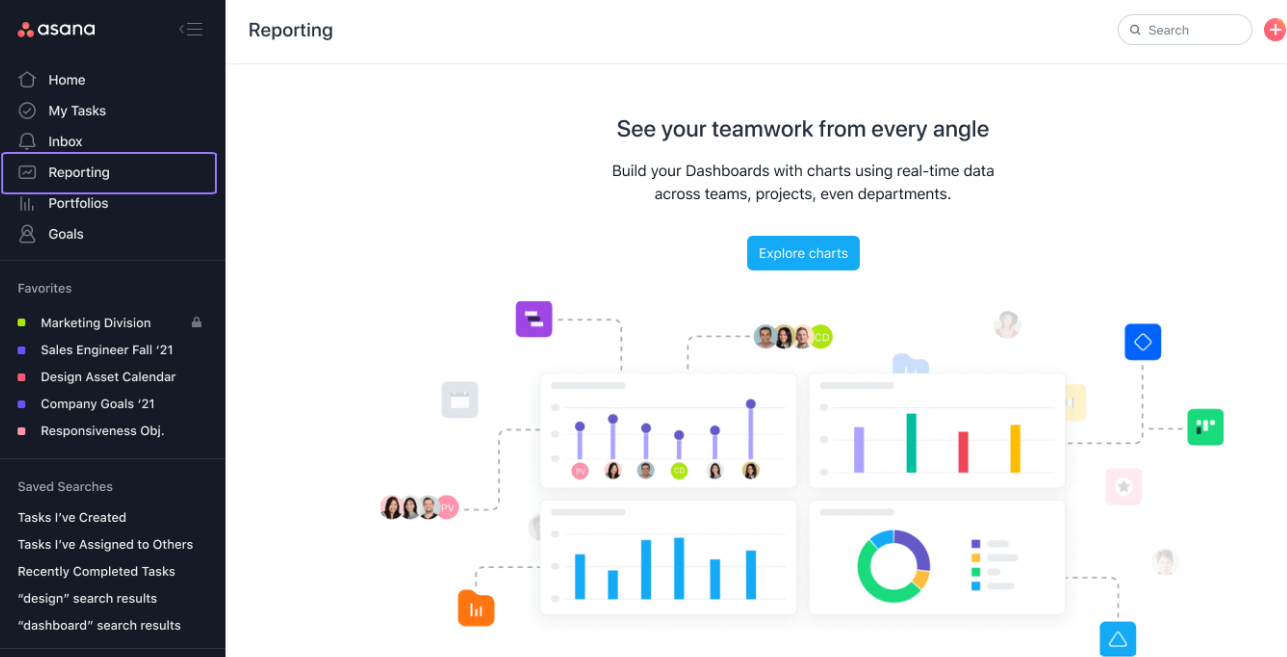
Integrations
Asana’s top integrations include Microsoft Teams, Slack, the Asana for Gmail add-on, Asana for Adobe Creative Cloud and Google Calendar.
Pros
- User-friendly reporting and task management.
- Effective goal alignment features.
- Wide range of integrations.
Cons
- Limited depth in analytical features.
- Real-time analytics are somewhat restricted.
Why we chose Asana
We simply selected Asana for its user-friendly approach to task-based reporting. Asana is also highly effective when it comes to aligning tasks with organizational goals.
For more information, check out our full Asana review.
Hive: Best for high-level project reporting

Hive is recognized for its high-level reporting capabilities, offering a suite of options for a variety of project management use cases. With features like goals, analytics dashboards and timesheet reporting, Hive provides a comprehensive tool for gaining visibility and gathering insights into projects.
Pricing
Hive has two premium plans atop a free plan. Teams at $12 per user per month when billed annually and $18 when billed monthly, and Enterprise, whose prices aren’t publicly listed.
Features
- Goals for setting, tracking and monitoring goals across teams.
- Analytics dashboards to showcase project status, project breakdowns and more.
- Timesheets reporting to analyze data across timesheets.
- Multiple views like Portfolio, Summary, Table, Kanban and more (Figure C).
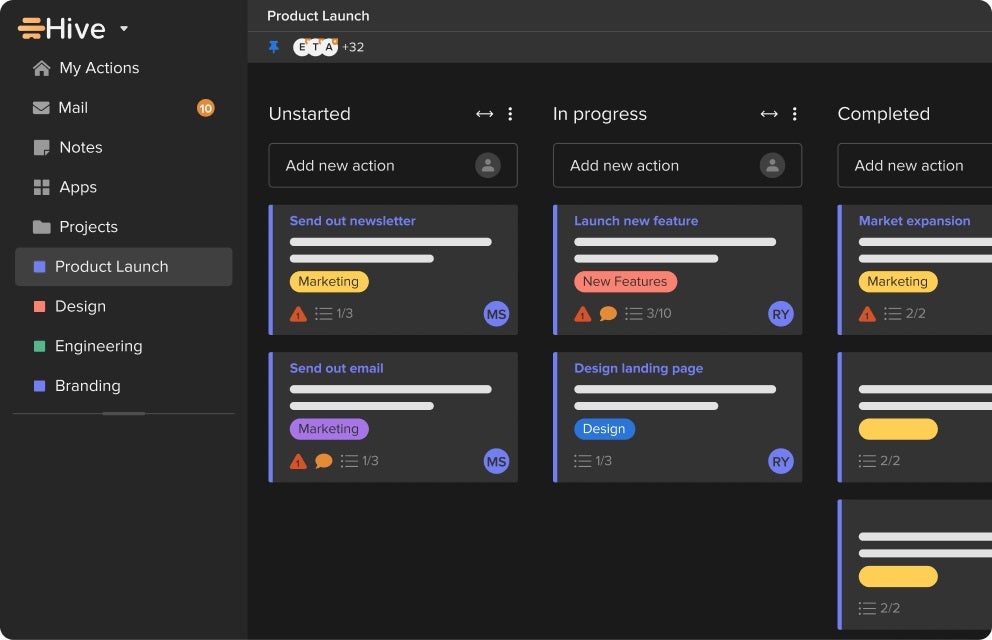
Integrations
Hive’s top integrations include Google Calendar, Gmail, Google Sheets, Google Drive and Slack.
Pros
- Customizable high-level reporting options.
- Variety of views for different reporting needs.
- Efficient project and action management features.
Cons
- May require initial setup time to customize views.
- Some advanced features might be available only on higher-tier plans.
Why we chose Hive
We selected Hive for its versatile high-level reporting options and customizable views. They bring a flexible and comprehensive overview to projects.
For more information, check out our full Hive review.
Google Looker: Best for data-driven decision-making
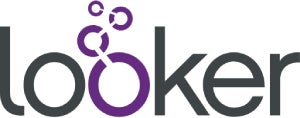
A rather different entry from most tools on this list, Google Looker stands as a unified business intelligence platform that excels at turning data into actionable insights. It offers self-service BI that allows users to access, analyze and act on up-to-date, trusted data. As a reporting tool, Looker offers reliable data experiences at scale and empowers users with real-time insights.
Pricing
Looker has a 30-day free trial, and its Standard plan costs $5,000 per month. For an annual quote, as well as quotes for the Enterprise and Embed plans, contact Google sales.
Features
- Embedded analytics and applications for enhanced data experiences.
- Data modeling to unify business metrics across teams and applications.
- Real-time insights to empower users with up-to-date information.
- An extensive template gallery for templates on many of Google’s applications (Figure D).
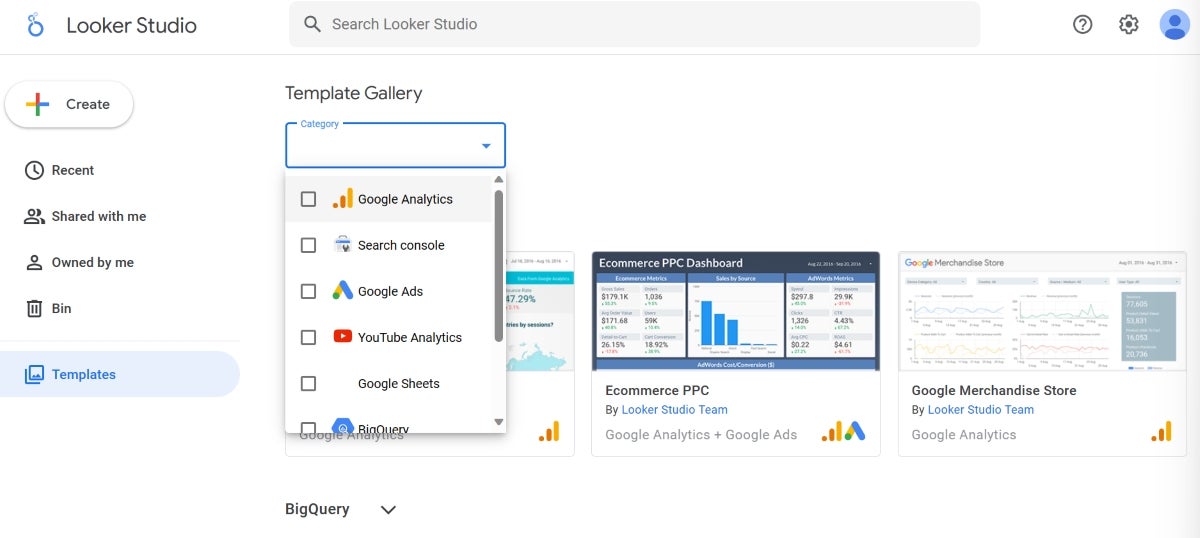
Integrations
Looker offers extensive integration capabilities, including BigQuery, Spanner, Cloud SQL and Cloud Storage.
Pros
- Unified platform for all BI needs.
- Real-time insights for up-to-date decision-making.
- Extensive integration capabilities with data sources.
Cons
- Pricing transparency could be improved.
- May require a learning curve to fully utilize advanced features.
Why we chose Google Looker
Google Looker’s reporting capabilities can be seen particularly through its embedded analytics and real-time insights. It easily unifies business metrics across teams and applications. It’s also a great tool for users predominantly using applications in the Google ecosystem.
Wrike: Best for customizable project reporting

Wrike stands out for its highly customizable reporting features. This flexibility, combined with Wrike’s thorough resource management and advanced analytics, makes Wrike competent enough to provide detailed insights into project performance and resource allocation and flexible enough to adapt to various workflows.
Pricing
Wrike has five plans: the ones with prices listed are the Free plan, Team plan at $9.80 per user per month and Business plan at $24.80 per user per month. The Enterprise and Pinnacle plans’ pricing plans aren’t publicly listed.
Features
- Customizable reports for tailored project insights (Figure E).
- Resource management to monitor progress and identify risks.
- Advanced analytics for deep visibility into project performance.

Integrations
Wrike’s top integrations include Jira, GitHub, Google Sheets, Azure DevOps and HubSpot.
Pros
- Highly customizable reporting options.
- Comprehensive project and resource monitoring.
- Advanced analytics capabilities.
Cons
- Customization options may require time to master.
- Extensive features can be overwhelming for newcomers.
Why we chose Wrike
Wrike has robust reporting capabilities and customizable features, which give users the flexibility and depth needed to gain extensive insights into their projects and resources.
For more information, check out our full Wrike review.
monday.com: Best for visual project tracking

monday.com is a favorite among teams that love visual task management and prioritize ease of use as it offers a visually intuitive platform for project tracking. Its advanced reporting features, such as stacked charts and workload views, provide a thorough overview of project progress and team capacity. monday.com’s dashboard customization is very flexible; this enables teams to mold their reporting to meet their project needs.
Pricing
monday has a free plan and a handful of premium plans, namely, Basic at $9 per seat per month, billed annually, or $12 per seat billed monthly; Standard at $12 per seat per month, billed annually, or $14 per seat billed monthly; Pro at $19 per seat per month, billed annually, or $24 per seat billed monthly; and Enterprise, which offers customized pricing.
Features
- Stacked charts for multi-dimensional data analysis.
- Workload views for balanced resource allocation.
- Pivot tables for detailed data breakdowns.
- Customizable dashboards for tailored project insights (Figure F).
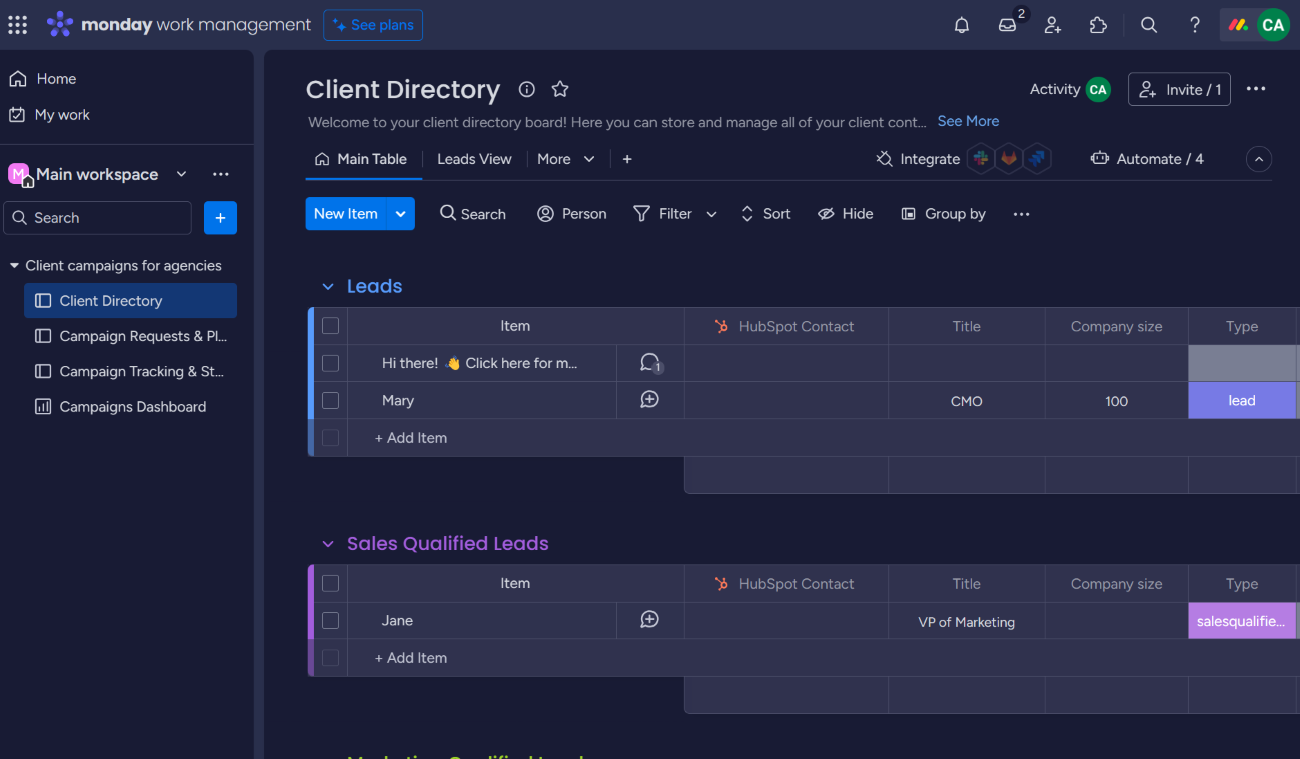
Integrations
Some of the best monday.com integrations include GitLab, OneDrive, Todoist, Slack and Microsoft Teams.
Pros
- Highly visual and intuitive interface.
- Advanced reporting for comprehensive project insights.
- Flexible dashboard customization.
Cons
- Can be overwhelming for new users due to numerous features.
- Some advanced features require higher-tier plans.
Why we chose monday.com
monday.com is a visually intuitive platform and has advanced reporting capabilities. It delivers a balance between visual project tracking and in-depth reporting.
For more information, check out our full monday.com review.
ClickUp: Best for all-in-one project management

ClickUp is recognized for its all-in-one approach to project management, offering a wide range of features from task management to time tracking and goal setting. Its reporting features are designed to provide teams with insights into productivity and project progress, supporting data-driven decision-making. ClickUp’s customizable dashboards and reporting tools allow teams to monitor key metrics and track performance effectively.
Pricing
ClickUp offers a generous free forever plan alongside three premium tiers: Unlimited at $7 per user per month when billed annually, or $10 per user per month when billed monthly; Business at $12 per user per month when billed annually, or $19 per user per month when billed monthly; and Enterprise that needs prospective users to contact ClickUp for a custom quote.
Features
- Comprehensive dashboards for project overview (Figure G).
- Customizable reporting for tailored insights.
- Goal tracking to align efforts with objectives.
- Time tracking to monitor task durations and productivity.
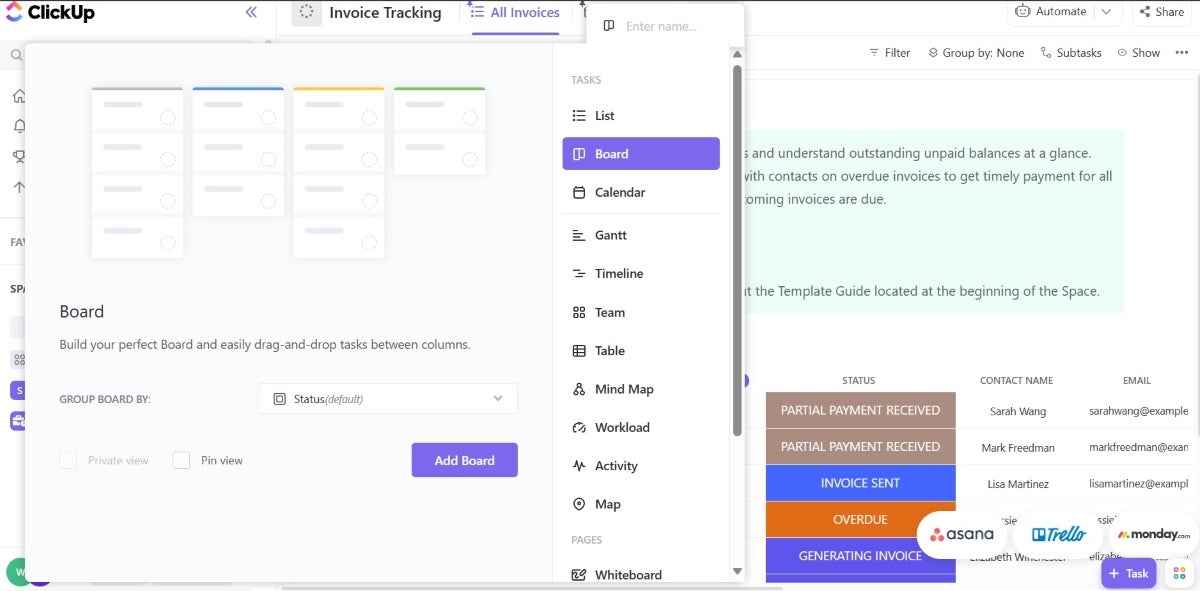
Integrations
Some of ClickUp’s top integrations include Gmail, Zoom, HubSpot, Make and Google Calendar.
Pros
- Versatile all-in-one project management solution.
- Extensive customization options for dashboards and reporting.
- Generous free plan with substantial features.
Cons
- Steep learning curve due to feature richness.
- Customization can be time-consuming.
Why we chose ClickUp
We included ClickUp because of its comprehensive feature set and flexibility, offering teams an all-in-one solution for project management and reporting. It proves suitable for a wide range of project types and sizes.
For more information, check out our full ClickUp review.
Jira Software: Best for agile project management

Jira Software is tailored for agile project management with specialized reporting features like sprint reports, burndown charts and velocity charts. These agile-centric reports give teams critical insights into their agile processes to help them optimize workflows and improve sprint planning. It’s worth considering for software development teams and those that follow scrum or kanban frameworks.
Pricing
Jira offers a free plan for 10 users max. Its premium plans are the Standard plan at about $8.15 per user per month and the Premium plan at about $16 per user per month. It also offers an Enterprise plan that’s billed annually. However, you need to contact Jira for a quote.
Features
- Sprint reports for tracking sprint progress (Figure H).
- Burndown charts for visualizing task completion.
- Velocity charts for assessing team performance over sprints.
- Cumulative flow diagrams for Kanban teams.

Integrations
Jira has extensive integrations with development tools like Bitbucket, Confluence, GitHub, Opsgenie, Jenkins and Dynatrace.
Pros
- Tailored for agile project management.
- Comprehensive reporting for scrum and kanban teams.
- Wide range of integrations with development tools.
Cons
- Primarily focused on software development teams.
- Can be complex for non-technical users.
Why we chose Jira Software
Jira Software has robust agile reporting features and is capable of providing deep insights into agile project management processes, especially for teams practicing scrum or kanban methodologies.
For more information, check out our full Jira Software review.
Tableau: Best for data visualization

Tableau sets the standard for data visualization, offering a wide range of chart types and interactive dashboards that make complex data understandable at a glance. As reporting software, it offers a user-friendly interface and powerful data handling capabilities for users to create detailed and insightful visual reports.
Pricing
Tableau’s pricing starts at $15 per user per month, with its highest tier costing $75 per user per month, both billed annually.
Features
- Wide range of visualization options.
- User-friendly interface for non-technical users (Figure I).
- Powerful data handling and processing capabilities.
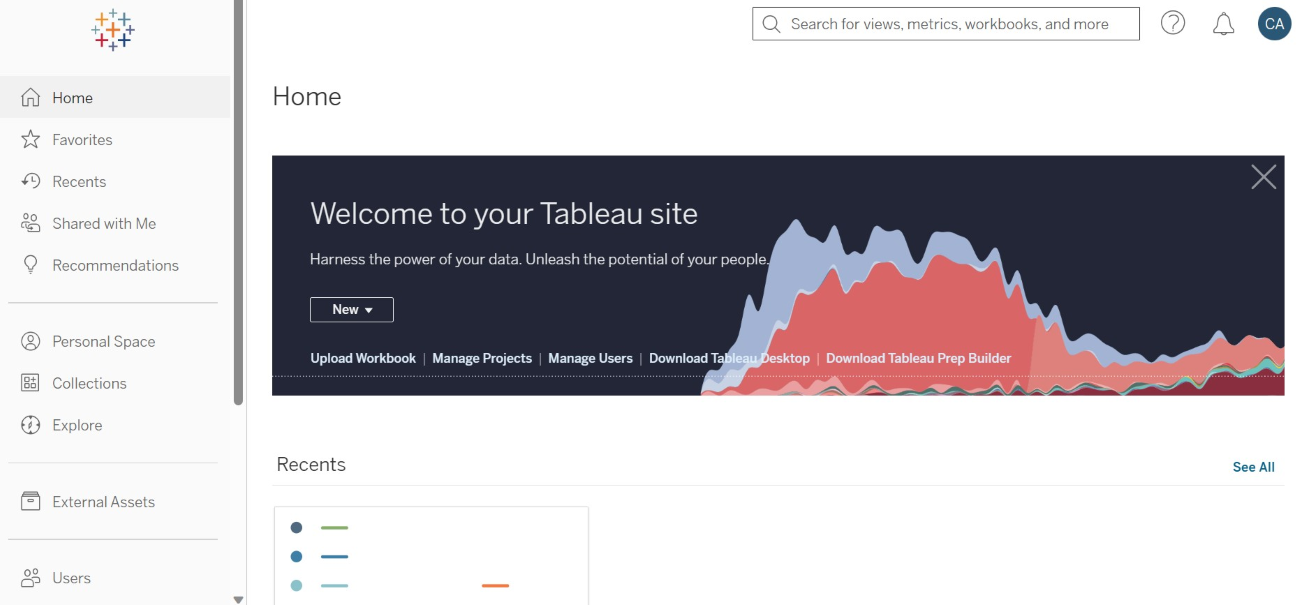
Integrations
Tableau’s top integrations include Salesforce, Google Analytics, Microsoft Excel, Amazon Redshift and Snowflake.
Pros
- Leading data visualization capabilities.
- Intuitive interface for easy use.
- Strong data connectivity options.
Cons
- Higher price point compared to some competitors.
- Can require significant resources for large datasets.
Why we chose Tableau
We considered Tableau because of its unparalleled data visualization capabilities and user-friendly interface. It should make it to your shortlist if your teams value both data accessibility and detailed reporting.
For more information, check out our full Tableau review.
Power BI: Best for Microsoft ecosystem integration

Power BI is a key player in the reporting and analytics space, especially for those deeply embedded in the Microsoft ecosystem. Its seamless integration with other Microsoft products, like Excel and Azure, makes it a no-brainer for teams that want compatibility and ease of use with their reporting tools. What makes it a great reporting and analytics tool is its ability to handle large datasets and provide advanced analytics, including AI capabilities and custom visualizations.
Pricing
Power BI offers a free version, with premium plans starting at $10 per user per month for the Pro plan and $20 per user per month for the Premium plan.
Features
- Seamless integration with Microsoft products.
- Advanced analytics with AI capabilities.
- Custom visualizations for personalized reporting (Figure J).
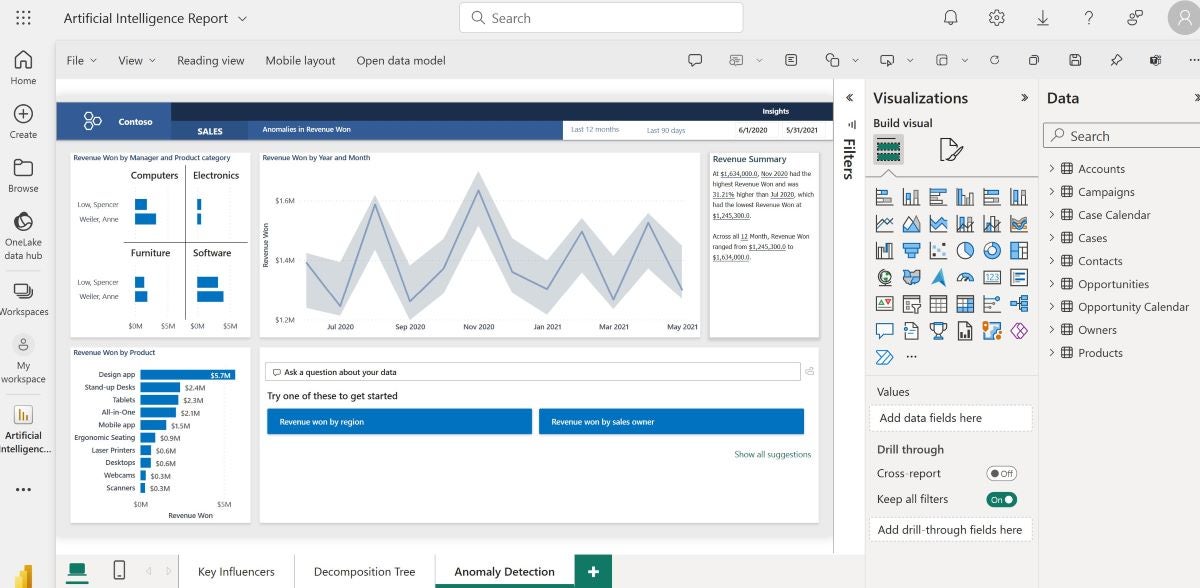
Integrations
Aside from a variety of tools in the Microsoft ecosystem like Microsoft Office 365, Power BI’s top integrations include Asana, HubSpot, Google Sheets and Salesforce Pardot.
Pros
- Strong Microsoft integration.
- Comprehensive analytics and AI features.
- Flexible pricing with a robust free version.
Cons
- Can be complex for new users.
- Limited integration outside the Microsoft ecosystem.
Why we chose Power BI
We chose Power BI due to its strong analytics capabilities combined with its seamless integration with tools in the Microsoft ecosystem. It’s a particularly fitting choice for teams that already use Microsoft products.
For more information, check out our full Power BI review.
Key features of reporting software
Real-time analytics
Real-time analytics allows users to view, assess and analyze data as it flows into the business, which can be displayed on dashboards or reports. With this, users get to make decisions faster since they get instant, descriptive insights from the most current data.
Custom reports
Custom reports save time as they automate the data gathering and report generation processes. After the initial setup, reporting processes can be entirely streamlined, with live data feeds ensuring that any additional requests can be quickly addressed by making changes to existing reports.
Dashboard customization
Dashboard customization is crucial in reporting software as it allows users to set up their reporting environment based on their needs. Custom dashboards can provide in-depth data on various aspects of business operations, illustrating potential revenue and areas where improvements are needed. Businesses can mix and match data sources for a comprehensive view of their digital environment.
Automated reporting
This kind of reporting streamlines the process of generating regular reports and reduces the manual effort required while making sure that stakeholders receive timely updates. Users can schedule report generation and ensure that reports are always current and reflect the latest data.
Data visualization
Data visualization transforms complex datasets into graphical representations, making it easier to understand trends, patterns and outliers. This feature helps to make data more accessible and actionable, which enables users to quickly grasp the insights presented in the data.
How do I choose the best reporting software for my business?
First things first, when it comes to choosing the best reporting software for you, you must match a tool’s capabilities to your needs. For small to medium-sized businesses, tools like Zoho Analytics and ClickUp offer a vast feature set at a more accessible price point, which makes them great options when seeking value without compromising on functionality. Larger enterprises or those with more complex reporting and data analysis needs might lean towards Power BI or Tableau, known for their advanced analytics and integration within larger ecosystems.
Consider the types of reports you need, the data you’re working with and who will be using the tool. For teams that prioritize real-time data and collaboration, monday.com and Asana provide user-friendly interfaces and seamless integration with other productivity tools. On the other hand, if your focus is on in-depth data analysis and visualization, Tableau’s extensive customization options and Power BI’s deep Microsoft integration stand out.
In essence, the best reporting tool is one that not only fits your budget and technical requirements but also grows with your business, adapting to changing needs and helping you make informed decisions based on accurate, up-to-date data.
Methodology
Our approach to identifying the top reporting tools for 2024 involved a detailed examination of each tool’s core features, ease of use, use cases and pricing. This allowed us to provide popular tools that cut across industries, use cases and team sizes. Additionally, we tested the tools where possible to understand how they approached reporting and compared our findings to verified reviews by real users. From this, we got to understand the pros and cons of each tool.
